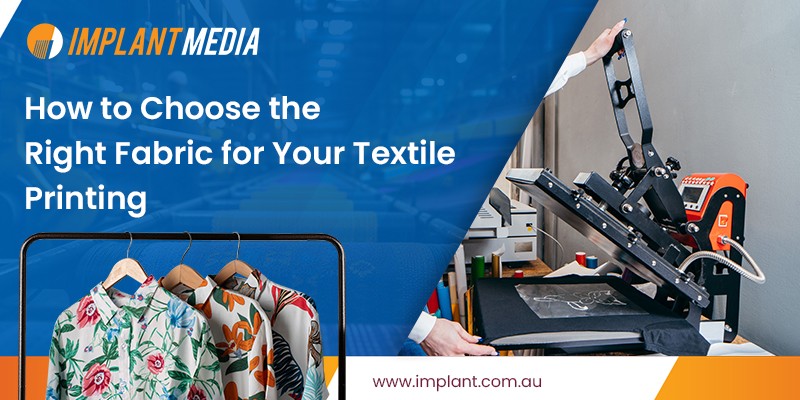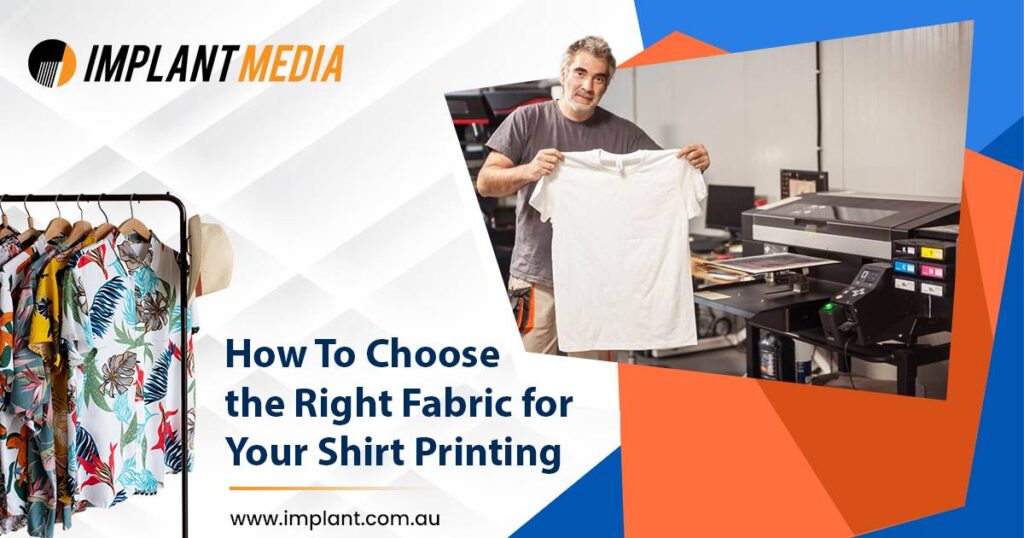Have you ever wondered why some printed shirts look vibrant and last longer while others fade and wear out quickly? Lurking behind this notion is the question of the best fabric used for shirt printing. Therefore, the choice of the fabric for textile printing can be a relative deal maker or a breaker when it comes to garment printing. But how is it possible to find out which fabric is the best fabric for shirt printing? Let this blog be your starting point on the things you need to take into account so that you can come to the right decision for your garment printing.
Understanding Shirt Printing: The BasicsUnderstanding Shirt Printing: The Basics
Shirt printing, which is also recognized as garment printing or textile printing, is a process that entails putting designs onto fabrics. Initially, the appearance of the printed shirt highly depends on the fabric used for shirt printing because various types have different outcomes when being treated with printing technologies.
Why Fabric Choice Matters in Garments Printing
Selecting the right fabric for garment printing is crucial because it affects the following:
Print Quality:
Each type of fabric handles the inks and their application with the particular print technologies variously, thus determining the quality and the intensity of the image held by the fabric.
Comfort:
The touch of the fabric determines the regularity of its use.
Durability:
Some fabrics withstand washing and wearing better than others, maintaining the print’s appearance over time.
Common Challenges in Choosing Fabric for Shirt Printing
Understanding Fabric Properties:
During the stage of the creation of the product, one has to determine how the used fabrics will perform in various conditions.
Durability Concerns:
Many often fail to know if the fabric is easy to wash and if it deteriorates or fades after so many wash episodes.
Print Quality:
How well does the fabric hold the ink for details and sharpness of prints, and which fabric finish is good for such?
Comfort:
Is the fabric comfortable to wear, especially for daily use?
Cost:
Illustrate how the price of the fabric impacts the total cost of the garments printing business.
Compatibility with Printing Techniques:
Not all fabrics are suitable for all types of textile printing.
Several Types of Fabric Used for Shirt Printing
Here are the few types of fabrics used for shirt Printing. Depending upon the printing techniques and the unique characteristics of the fabric, it is determined to use the required fabric for your garment printing.
Cotton
Among all the fabrics used for shirt printing and other garment printing, the most widely used fabric is cotton. It is:
Versatile:
Most suitable for screen printing, DTG (direct-to-garment) printing, and also for heat transfer printing.
Comfortable:
Easy and comfortable to wear(lightweight) it is the type of clothing most people like to wear most of the time.
Durable:
Resistant to general washing and wearing.
Polyester
Polyester is a synthetic fabric known for its:
Durability:
Long-wearing, maintains its share over time, and is resistant to stretching and shrinking.
Moisture-Wicking:
Very appropriate as a fabric that should be used for athletic activities and any form of intense movement.
Vibrant Prints:
Ideal for sublimation printing, producing vibrant and colorful prints which last for a long time.
Blends (Poly-Cotton)
Poly-cotton blends are unique blends of both Poly and Cotton, meaning they have some characteristics of both.
Comfort and Strength:
This is a blend of wearing the smooth-touch fabric of cotton with the durability of polyester fabric.
Cost-Effective:
Most of the time, they are more affordable than pure cotton or polyester materials.
Versatile:
These fabrics are fairly stable for the majority of kinds of printing and can be utilized constantly.
Rayon
Rayon is a fabric that is completely semi-synthetic by its nature.
Feels Soft:
Has smooth silk texture but feels somewhat velvety.
Prints Well:
Absorbs the dyes; this feature makes it suitable for bright prints.
Needs Care:
Specifically, the fabrics have to be washed carefully to maintain their quality.
Tri-Blends
This fabric is made out of cotton, polyester, and rayon, providing the following:
Softness:
Soft and extremely comfortable.
Unique Texture:
It gives a vintage look and feel
Good Printing Surface:
This is fully compatible with most types of printing, and it provides relatively high-quality printed items.
How to Choose the Right Fabric for Your Textile Printing

Consider the Purpose
Determine your shirt’s or garment’s intended use:
Casual Wear:
Ideally, cotton or blends are suitable for the job as they are comfortable and versatile.
Sportswear:
If the focus is on the ability to move moisture away from the skin and product durability, polyester or poly-cotton blends should be used.
Fashion Wear:
Choosing tri-blend or rayon is a great choice because it offers a unique texture and is relatively more fashionable.
Evaluate the Printing Technique
Match the fabric with the printing technique:
Screen Printing
This technique is very versatile, and it is recommended for cotton and cotton blends. These give vibrant colors and prints with good resistance to wash.
Direct-to-Garment (DTG) Printing
DTG print is appropriate for detailed and colorful images. The kind of material that would be ideal to be used on the device includes cotton fabric providing a smooth finish.
Sublimation Printing
Polyester fabric can benefit from Sublimation printing. It creates vibrant, long-lasting prints by infusing the dye into the fabric.
Heat Transfer
Heat transfer involves designing on a transfer paper placing the fabric over it and then applying heat to transfer the ink on the paper on the fabric. This method is suitable for smaller orders and allows for intricate designs with multiple colors.
Balance Cost and Quality
Consider your budget while aiming for the best quality:
Budget-Friendly Options:
Poly-cotton blends are one of the cheaper fabrics in the market and also among all the fabrics with good performances.
Premium Choices:
Pure cotton or tri-blends are comfortable as casual wear and are ideal fashion prints on the apparel.
Test Samples
Always test fabric samples before committing:
Print Tests:
Check how the material interacts with the selected printing technique.
Wear Tests:
Pressure of the fabric on the skin, the quality of the fabric, and how long it lasts.
Fabric Weight
Print resolution is usually associated with the weight of the fabric at times in grams per square meter (GSM) in this regard shall be employed to influence the print and the stain resistance. On the other hand, fabrics that are tough and dense have longer durability than slim and delicate fabrics.
Comfort & fit
Comfort is significantly important in the clothes that are used frequently. Choose the fabric that would make the apparel soft close to the skin and which would give the right kind of fitting.
Factor in Durability
Consequently, the aspect of selling the shirt’s washing frequency should be centered on how often the shirt will be used. Select materials that will not wear out easily or lose color to be able to withstand frequent use and maintain their appearance over time.
Achieve Perfection with Stunning Shirt Printing
Choosing the right fabric is just the first step in creating stunning printed shirts. Here are some additional tips to ensure your designs stand out:
Pre-Treat the Fabric:
The fabric should be pre-treated for it to have a better adherence of the ink to the cloth mostly for DTG printing.
Color Calibration:
Calibrate your printer and inks for accurate color reproduction.
Quality Control:
Inspect printed shirts on the collar, seams, sleeve length, and overall print of the shirts before making the order.
Care Instructions:
Provide customers with proper care instructions to maintain the quality of the prints.
Implant Media at Your Service
At Implant Media, we specialize in high-quality shirt printing services tailored to your needs. Whether it is an event that you need some branded T-shirts for the people attending or if you need a large number of custom printed shirts, we bring out the best in as per the advanced technologies and the novel ideas in the line. We offer a range of printing techniques like screen printing, DTG, and heat transfer printing, ensuring your designs look stunning on the chosen fabric for your textile printing.
Glam up Your Closet with Perfect Prints
Knowing about the fabric used for shirt printing and selecting the appropriate one for your garment printing is crucial in getting the best outcome. In this way, by understanding the features of fabrics and choosing the correct method of printing, you can come up with stunning textile printings on T-shirts and other apparel items that will look good and will remain serviceable for a long time. Trust Implant Media to bring your designs to life with our top-notch printing services.
Are you ready to get down to your next shirt printing project? Get in touch with Implant Media now to learn how we could assist you with the production of these fine items.


